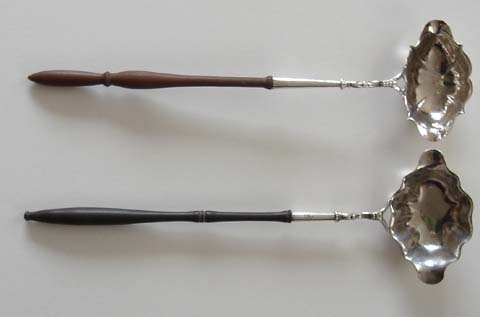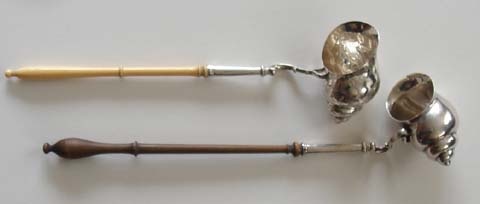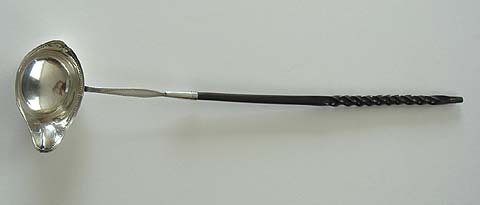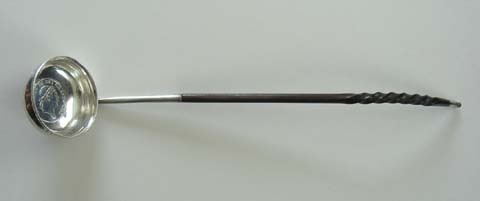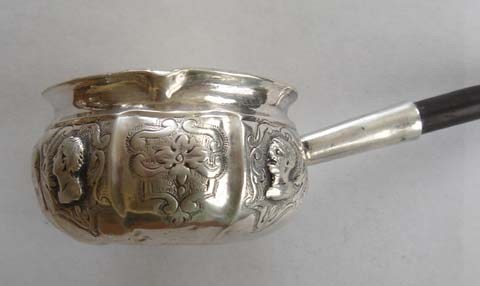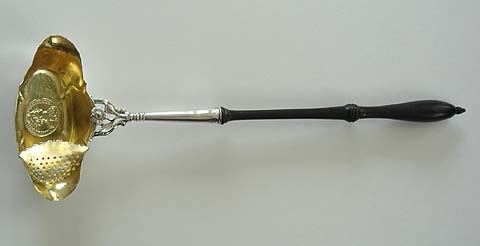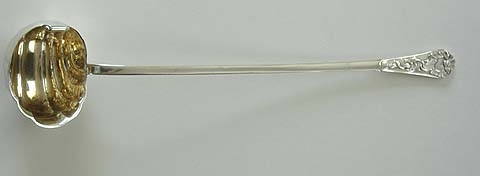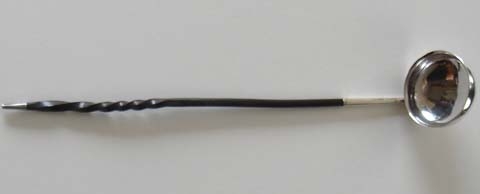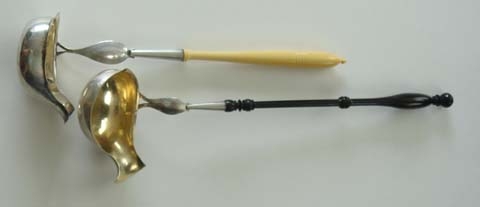 ASSOCIATION OF SMALL COLLECTORS OF ANTIQUE SILVER
ASSOCIATION OF SMALL COLLECTORS OF ANTIQUE SILVERASCAS
| article # 67 |
|
next |
previous |
"LET'S DRINK AND BE MERRY"
|
|
Punch was a popular party drink introduced in the middle
of the 17th century. The name is derived from the
Sanskrit panca, meaning five and pointing to the five
key ingredients: water, sugar, limes or lemons, spices
and spirit
(click for note 1). Punch bowl, punch goblets, sugar dredgers, bottles with silver or even enameled labels, lemon/orange strainers and ladles were all punch paraphernalia and as such "must haves" in elegant households, some Georgian homes were even equipped with "puncheries" (click for note 2). This study concerns itself with punch ladles only and more specifically 18th and 19th century’s examples. They are found still relatively often in today’s market place and are so within reach of interested collectors. Still useful in the modern household, they are also enough varied in style and therefore qualify easily as collector’s items. The 17th century punch ladle was a substantial piece of silver with heavy round bowl and a silver handle. Due to the scarcity of silver at the beginning of the 18th century new styles had to be developed. The introduction of a non-silver handle and lighter bowls were natural consequences. Around 1735 the bowls were round or egg shaped (Fig. 1).
An exception to the rule is the Austro-Hungarian ladle with silver handle, made ca. 1750 in Kronstadt, the grapes and vines motif on the handle as well as the fluted silver-gilt bowl point to a definite use as punch ladle (Fig.9).
Some ladles show monograms, crests or coat of arms. In the 18th century decoration was used sparingly contrary to late Georgian and early Victorian ladles which were often heavily chased. Inscriptions on punch ladles are not very common. The following inscription is found on a Queen Ann punch ladle of 1712 and reads: "Gentlemen Archers. Of brandy with you there’s no lake, I gift you this for your punch to take. John Hamilton." Such a witty and contemporary inscription is a definite asset and will increase the value of the piece (click for note 3). On the Canadian market the English punch ladle is predominant. Most of them are London-made. Scottish punch ladles are rare, because Scots preferred claret to punch. A nice Scottish example is shown in Fig.10, a beautifully carved wood handle and an applied leaf motif on the socket contribute greatly to its charm.
Another one, made by William Homes jr., is shown in "Silver in American life" (click for note 6). The Heritage collection in Old Deerfield has a double-lipped fluted ladle with carved wooden handle, by Jacob Hurd, and a punch ladle, featuring a twisted whale bone handle, is made from a coin by Halsted and Myers, New York, 1763. (click for note 7). A Myer Myer’s example is called ‘punch ladle’ (click for note 8) even though it has a - for a punch ladle atypical - silver handle with bright-cut decoration. Since there is no scarcity of American soup - or other ladles it can safely be assumed that these were used for filling punch into the goblets. To prove the point: the shop inventory of Joseph and Nathaniel Richardson, dated May 31, 1790, lists six punch ladles, but 36 soup ladles and 36 sauce ladles (click for note 9). Most punch ladles are marked with the exception of those made out of coins. English ladles are hallmarked in the bowl or on the outer rim of the bowl. There are virtually no known fakes. Later American-made reproductions in Georgian styles can be found. Determining factor for including a ladle into your collection should definitely be condition. All ladles are prone to splits and repairs to the stem which joins bowl to handle. Fine examples - even if much more expensive - are always more desirable and will give you lasting pleasure.
|

